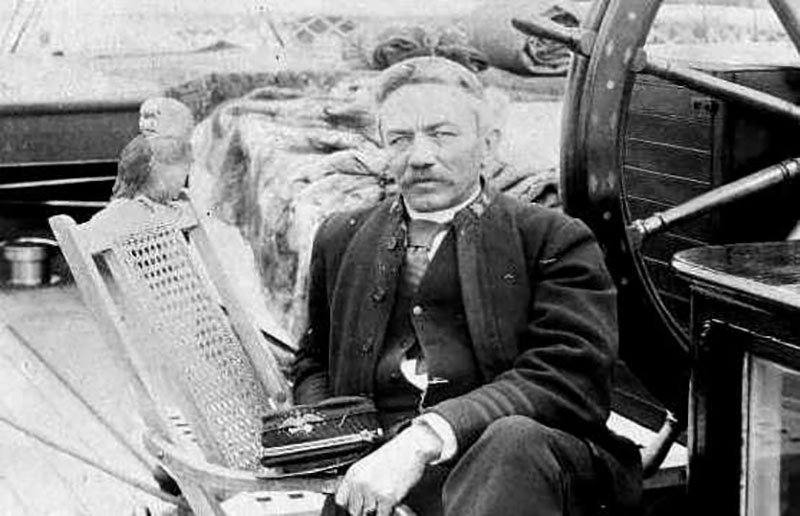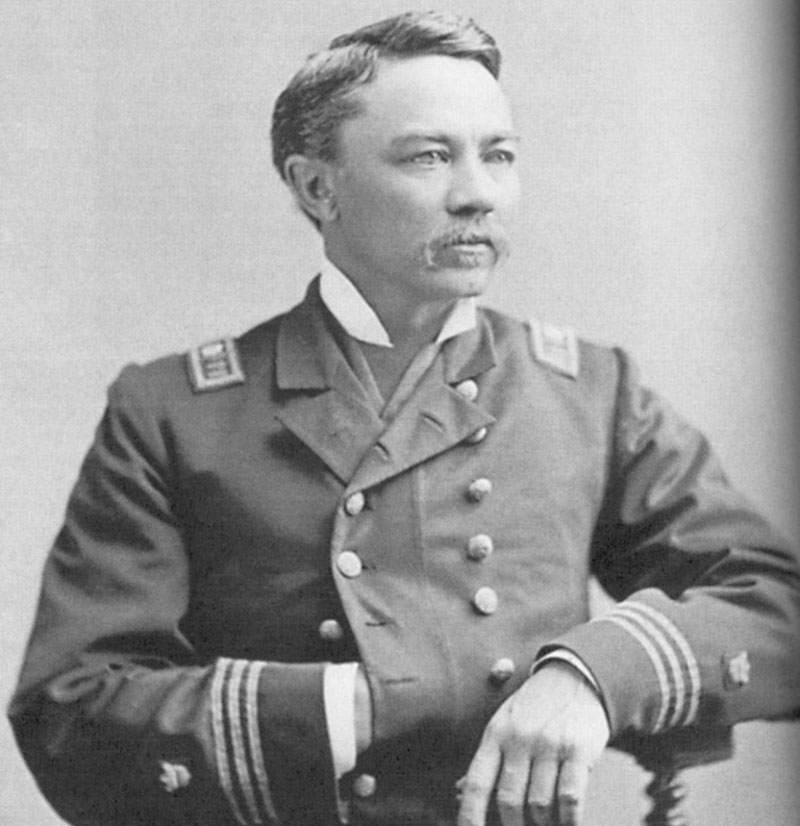
By William H. Thiesen, Historian, Coast Guard Atlantic Area

The colorful Captain “Hell Roarin’” Mike Healy, first African-American ship captain and famed skipper of the Bear. Image courtesy of the U.S. Coast Guard. Download image (jpg, 101 KB).
When I am in charge of a vessel, I always command; nobody commands but me. I take all the responsibility, all the risks, all the hardships that my office would call upon me to take. I do not steer by any man’s compass but my own.
In the above quote, Captain Michael Augustine Healy described his command philosophy. Healy’s career tied him to the taming of America’s western maritime frontier, earned him the nickname “Hell Roaring” Mike Healy, and made him the most famous captain in Coast Guard history.
Born in 1839 on a plantation near Macon, Georgia, Healy was the son of a white plantation owner and a slave. To prevent his children’s enslavement, Healy’s father sent Michael north with his siblings to be raised and educated in Massachusetts. Healy left school and came up through the enlisted ranks on merchant ships. He became a merchant marine officer before applying for an officer’s commission in the Revenue Cutter Service.
In March 1865, just a month before his assassination, President Abraham Lincoln signed Healy’s commission. Healy became the first U.S. sea service officer of African descent and the first to command a federal ship. However, despite his ethnicity, Healy appeared to be Caucasian and never admitted his racial background to others.
Two years after receiving his commission, Healy served as navigation officer and third in command of the cutter Reliance, on its voyage from the East Coast around Cape Horn to San Francisco. The trip began in August 1867 and included eight brutal days of gale-force winds and mountainous seas while the 110-foot topsail schooner slugged its way around “The Horn.” This trip cemented a friendship between Healy and Captain John Henriques, who served as Reliance’s commanding officer. A few months after Reliance arrived in San Francisco, the Treasury Department ordered it to set sail for the newly acquired territory of Alaska to enforce customs laws.

An 1880 photograph of Michael A. Healy, first commissioned African-American officer in federal service. Image courtesy of the U.S. Coast Guard. Download image (jpg, 237 KB).
In October 1868, Reliance sailed for Sitka, becoming one of the first cutters to serve in the treacherous waters of the Alaska Territory and the first one to enforce U.S. laws in Alaskan waters. At that time, revenue cutter missions included helping establish the territorial government, charting coastal waters, and protecting endangered seal herds from poachers.
From Reliance, Healy and Henriques transferred to the Wayanda and, four months later, they transferred to the steam sailing cutter Lincoln. Healy returned with Henriques to the East Coast after their tour on board the Lincoln ended. During these shared cutter assignments, Healy learned a great deal from Henriques, possibly the Service’s most experienced cuttermen in the late 1800s.
In 1874, Henriques received orders to ferry the new cutter Rush around Cape Horn to San Francisco and selected Lieutenant Healy as his executive officer. After the delivery, Henriques returned to the East Coast to establish the Revenue Cutter Service Academy, but Healy remained behind to become a veteran of Alaskan waters and a skilled ice pilot. Healy commanded West Coast cutters, such as the Corwin. In April 1886, he took command of the Bear, after it sailed from the East Coast around Cape Horn and arrived at its new homeport of San Francisco.
Healy commanded Bear on the Bering Sea Patrol, an annual cruise that revenue cutters began in 1874, the same year that he returned to the West Coast. Each of the Bering Sea Patrols covered between 15,000 and 20,000 nautical miles. Late in his career, Healy described the pressures of commanding Bear on these cruises:
...to stand for forty hours on the bridge of the Bear, wet, cold and hungry, hemmed in by impenetrable masses of fog, tortured by uncertainty, and the good ship plunging and contending with ice seas in an unknown ocean.
After 10 years of Bering Sea Patrols, the stress of commanding Bear encouraged Healy’s drinking problem. In 1896, the Service relieved him of command, dropped him to the bottom of the captain’s list, and placed him out of service for four years. The Service later reinstated Healy and he served on a number of cutters before retiring in 1903 as the third-most senior officer in the Revenue Cutter Service. Physically spent, Michael Healy died in 1904 at age 65 and was laid to rest at Holy Cross Catholic Cemetery near San Francisco.
Michael Augustine Healy made a lasting impression on American history as the first captain of Bear during its initial Bering Sea Patrols. Today, Healy is the namesake for the icebreaker Healy (WAGB-20) stationed at Seattle, Washington. As a powerful law enforcement officer in a lawless maritime frontier, he helped shape the history of Alaska as well as the Coast Guard.